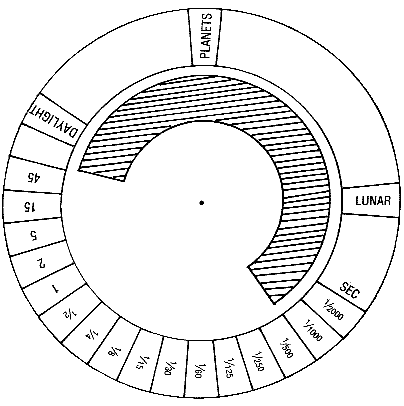Astro Exposure Calculator
by Michael Oates
This exposure calculator is designed for both astronomical and terrestrial use.
Instructions
- First download each of the 3 discs and print out onto thick paper or even
card if your printer will allow this.
- Paste the prints onto card.
- Cut out the 3 disks, then carefully with a sharp knife cut out the 2
shaded portions.
- Next pierce the centres of each card with a sharp point.
- Pass a paper fastener through all 3 disks, the smallest on top and the
largest on the bottom.
- Spread out the fastener on the back an secure with tape.
- The calculator is now ready for use.
How to use the Calculator
I will explain with an example...
Suppose you wish to photograph the moon at quarter phase and the film you are
using has a speed of 100 ISO.
-
First use the pointer marked LUNAR and move the outer
disk until it is aligned with QUARTER.
-
Then making sure the two outer disks don't move rotate
the inner disk until '100' is seen in the small window.
-
You can now read off the exposure required from the 2
scales 'f' and 'sec', such as 1/60th sec at f8, or 1 sec at f64.
For planetary
photographs use the PLANET pointer.
You can even work out the correct exposure for ordinary daytime photography
by using the DAYLIGHT pointer.
Exposures should be bracketed either side of the indicated exposure for a
number of reasons.
-
If the object is low in the sky, the atmosphere is thicker
and absorbs more light from the object.
-
The planets vary in brightness depending on the phase
of the planet its distance from us and its distance from the Sun.
-
Different makes and types of film respond differently
to exposures over 1 second in length. The emulsion becomes tired, with the
result that the image is not as dense as it should be. This is called reciprocity
failure. That is why, on the calculator the exposure lengths over 2 seconds
do not double, but in fact treble with each increase in exposure. You should
only use this as a guide, as I can only approximate since many different
films will be used.
-
Slide film needs to be exposed much more accurately.
Print films however can stand a one stop over or under exposure.
Notes
The figures used in the exposure calculator were based on
tables published in Michael Covington's book "Astrophotography for the Amateur".
I've taken many photographs with this calculator and I find
the exposures always spot on. (but then I may be slightly biased :-))
You are free to use the calculator and pass it on to friends.
But I do ask, please do NOT re-distribute, without permission, or sell/pass
this on to other parties for profit.
Copyright © 1995 Michael Oates
The Disks
 Small Disk
Small Disk
 Medium Disk
Medium Disk
 Large disk
Large disk
Back to the M.A.S. Projects Page
Back to the M.A.S. Home Page
Manchester Astronomical Society
 Medium Disk
Medium Disk
 Small Disk
Small Disk